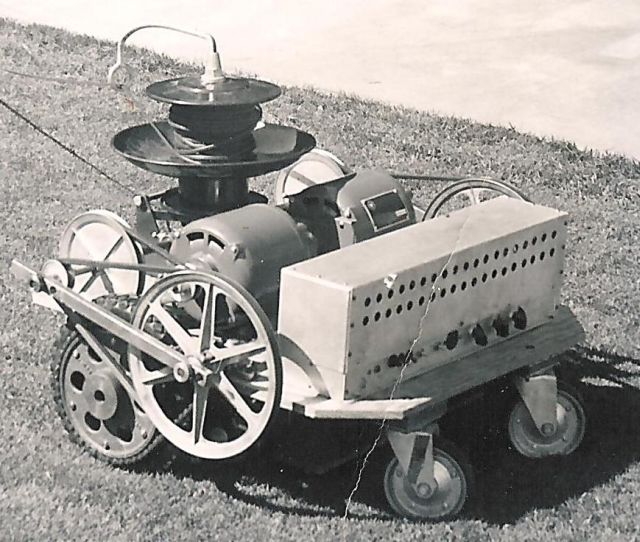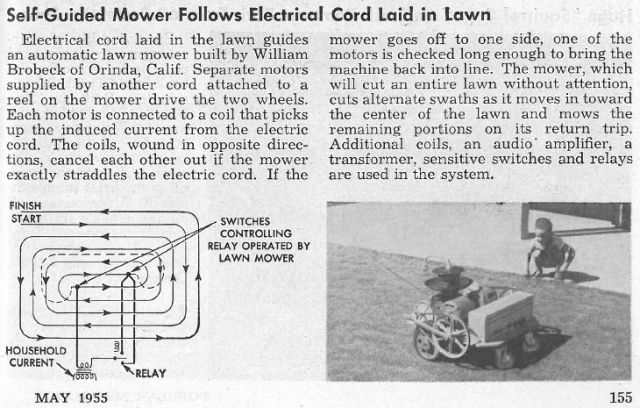
William "Bill" M. Brobeck joined the UC Berkeley lab in 1937 and moved several years later to Orinda with his late wife, Jane Knox.
Their home became a local landmark in the mid-1950s, after Mr. Brobeck used his engineering talents to build an automatic lawn mower.
Neighborhood kids would gather outside the couple's backyard to watch the lawn mower effortlessly trim two large patches of grass. Mr. Brobeck had buried wires beneath the lawn that guided the automatic mower.
After leaving the Berkeley lab in 1957, Mr. Brobeck formed his own engineering company, Brobeck & Associates, and later founded the Cyclotron Corp. in 1965. The Cyclotron Corp. helped create practical uses for cyclotrons in cancer treatment and other medical uses.
He retired in 1988, holding 22 patents and an honorary degree from UC Berkeley.
Mr. Brobeck is survived by his wife, Gloria Brown Brobeck of Orinda; a son, Bill Brobeck of Moraga; two daughters, Kathy Brobeck of Massachusetts and Betts Coury of Oregon; and two grandchildren.

Brobeck's professional interests and bursting ingenuity extended way beyond the field of accelerator design. In 1972, for instance, he was hired by the U.S. Department of Transportation to develop pollution-free vehicles. Even in his retirement years Brobeck continued to design gadgets that made him as famous in his neighborhood as accelerators did in the world of science. Among them: an automated lawn mower that could start up by itself, head out onto the lawn and mow it before going back, turning itself off and recharging its battery. He also invented an automatic record changer and a car that ran on both gas and electricity.
The May 1955 issue of Popular Mechanics (p155) featured William Brobeck's lawn mower.

Self-Guided Mower Follows Electrical Cord Laid in Lawn
Electrical cord laid in the lawn guides an automatic lawn mower built by William Brobeck of Orinda, Calif. Separate motors supplied by another cord attached to a reel on the mower drive the two wheels. Each motor is connected to a coil that picks up the induced current from the electric cord. The coils, wound in opposite directions, cancel each other out if the mower exactly straddles the electric cord. If the mower goes off to one side, one of the motors is checked long enough to bring the machine back into line. The mower, which will cut an entire lawn without attention, cuts alternate swaths as it moves in toward the center of the lawn and mows the remaining portions on its return trip. Additional coils, an audio amplifier, a transformer, sensitive switches and relays are used in the system.
Bill's son William I. Brobeck has followed in his father's footstep by designing and patenting an automatic tennis court drying machine:
Publication number US7454846 B2
Publication date Nov 25, 2008
Filing date Apr 10, 2007
Priority date Apr 11, 2006
Abstract
An apparatus and method for automatically drying a tennis court or other flat surface after rainfall is provided. A robotic vehicle cooperates with a sensing unit preferably mounted on a fence adjacent the court or other paved surface. A sensing unit detects the onset and cessation of rain and then waits a predetermined amount of time. After waiting, the sensing unit transmits a signal to the robotic vehicle which actuates the vehicle. The robotic vehicle includes an on-board controller which is internally programmed with a map of the court including obstructions. The robotic vehicle automatically sponge rolls the entire court. A thermal imaging camera connected to the sensing unit then scans the court to determine if any wet spots remain. The location of any remaining wet spots is recorded and transmitted to the on-board controller of the robotic vehicle. The robotic vehicle then returns to the location of the wet spots and automatically sponge rolls and fan dries those remaining wet spots. The robotic vehicle then returns to a storage unit on or adjacent the paved surface where it is recharged and waits for further use.
See other early remote-controlled and robotic lawn mowers here.
Bill, I just ran across this and realized I never responded to your email. I did copy the 10 Commandments but couldn't find them so now I have another copy…also loved the tennis court dryer! Bill D.
Hi Bill,Â
Here is Bill’s Gospel as supplied by his son, Bill (so many Bills).
I had the pleasure of knowing your dad from a few years before his death. An amazing man, and he should have been included for the Nobel Prize. I recall the stories about the lawn mower too!
I would like a copy of his ten rules (commandments?) of engineering if you can send it to me.
All the best and thanks for keeping his memory alive.
Bill Darusmont
formerly at 109 Sleepy Hollow Lane